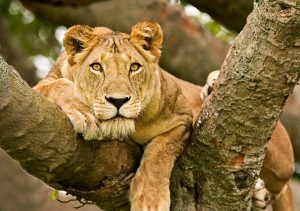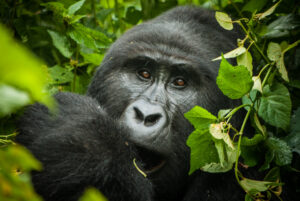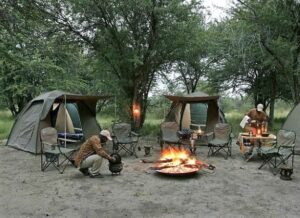ABOUT UGANDA
QUEEN ELIZABETH NATIONAL PARK
Queen Elizabeth National Park is Uganda’s most popular game reserve for Uganda wildlife safaris and definitely one most attractive national park in Uganda. It is located in the Western part of Uganda. The national park was established in 1952 after being visited and named after Queen Elizabeth the second the queen of England. Queen Elizabeth national park stretches from the crater-dotted foothills of the Rwenzori range in the north, along the shores of Lake Edward to the remote Ishasha River in the south; including a wide diversity of habitats that range from savanna and wetlands to gallery and lowland forest which can be enjoyed while on our Uganda safari tour and Uganda wildlife safaris tour with Amstel Tours and Travel. Queen Elizabeth national park has over 611 recorded bird species in the Kazinga channel sanctuary which covers an area approximately 207km. Kazinga Channel is believed to contain the world’s largest concentration of hippos in Uganda and you get to enjoy this while on the safari boat cruise with Amstel Tours and Travel after booking the unforgettable Uganda wildlife safari tour
Queen Elizabeth national park vegetation consists mostly of thickets of various types of small trees, including evergreens and acacias. The national park area has savannah grasslands and rain forests. The national park’s wildlife to look out for while on a Uganda safaris tour with Amstel Tours and Travel includes lions, elephants, leopards, hippopotamuses, chimpanzees and antelopes such as duiker, reedbuck topi and the tree climbing lions at the Ishasha sector
Queen Elizabeth national park is also referred to as the “the pearl of Africa” simply because of its fertile equatorial area which is scenic with two lakes connected by a channel overlooked by a high peninsula. Area has volcanic craters, tropical forest and grasslands. Queen Elizabeth national park has one of the highest biodiversity ratings in the world and you can’t look any further if you are on a Uganda safari tour
Numerous crater lakes in Queen Elizabeth national park gives an incredible scenery to look out for while on Uganda safari with Amstel Tours and Travel in the pearl of Africa. Have stopovers at Nyamununka crater lake also known as the hospital for wild animals, many visit it to have their wounds treated or the aging animals for its waters that contain Sulphur. Take a trip to the salt mining craters, Lake Katwe or Lake Bunyampaka. Enjoy the sun set over Lake Edward and Rwenzori’s in the backdrop. Ishasha sector of Queen Elizabeth national park is home to the famous tree-climbing lions that choose the branches of acacia trees after the night/early morning meals. The trees also provide the needed shed from the scotching sun while on the safari which raises them to experience the winds.
The Maramagambo Forest, south of the Kazinga Channel is a home to big numbers of chimpanzees and a number of monkey species; therefore, while at queen Elizabeth national park, you will get the track the chimpanzees in the kyambura gorge.
WILDLIFE IN QUEEN ELIZABETH NATIONAL PARK
Animals in Queen Elizabeth National Park
Queen Elizabeth national park is home to over 95 mammal species, which are the main attraction of the visitors to the queen Elizabeth national park. The national park has four of the ‘Big Five’ namely Elephant, Leopard, Lion and Buffalo. Queen Elizabeth national park is also home to thousands of hippos that populate the water shores of Kazinga Channel, which connects Lake George to Lake Edward – known to have the largest herd of hippos. Queen Elizabeth national park is an open Savannah spread with acacia and euphorbia trees that provide a habitat for leopards, elephants, lions, Uganda kobs, Topi, hyenas, and big herds of buffaloes, large families of banded mongoose, warthogs, bushbucks and waterbucks. While at the queen Elizabeth national park, look out for Chimpanzees and other primates in the adjacent Kyambura gorge and ‘underground forest’. Look for the black-and-white colobus monkeys, red-tailed monkeys, olive baboons etc while at queen Elizabeth national for the Uganda wildlife safari tour with Amstel Tours and Travel.
Birds in Queen Elizabeth National Park
 Queen Elizabeth national park is a birdwatcher’s haven with over 600 bird species and is an important Birding Area (IBA) according to Birding International. Queen Elizabeth national park has the highest number of birds found in any protected area in East Africa; which means if you are looking for Uganda birding safari tour, Amstel Tours and Travel will definatly give you that offer when you travel to queen Elizabeth national park for the Uganda safari tour and Uganda bird watching safari tour
Queen Elizabeth national park is a birdwatcher’s haven with over 600 bird species and is an important Birding Area (IBA) according to Birding International. Queen Elizabeth national park has the highest number of birds found in any protected area in East Africa; which means if you are looking for Uganda birding safari tour, Amstel Tours and Travel will definatly give you that offer when you travel to queen Elizabeth national park for the Uganda safari tour and Uganda bird watching safari tour
Queen Elizabeth national park has diverse habitat for birds from Savannah, numerous crater lakes, forests and woodland. There are different sections where you go birding while on a Uganda safari or Uganda birding safari photo tour in Queen Elizabeth national park i.e. Kasenyi area, Mweya peninsula, Imaramagambo and Kazinga channel. The bird species to look out for while on the Uganda birding safari photo tour and Uganda wildlife safari tour include, African mourning dove, Swamp flycatcher, Grey headed kingfisher, pin-tailed whydah, slender-tailed nightjar and collared pratincole. Look out for the flamingos at the salt lakes of Katwe and Bunyampaka.
WHAT SAFARI ACTIVITIES TO DO IN QUEEN ELIZABETH NATIONAL PARK?
Safari wildlife Game drives in Queen Elizabeth National Park
While in queen Elizabeth national park for Uganda safari tour, early morning or evenings are the best times to go game viewing mainly because the sun is not as hot and the cats prefer to hunt during these periods and you will enjoy the cats hunting in the wild while on Uganda wildlife safari game drives with Amstel Tours and Travel.
The safari wildlife game drives in Queen Elizabeth national park happen mainly in the Kasenyi area, which has the largest Kob mating ground. The area is famous for big cats because of the high population of Uganda Kobs which they prey on. Look out for herds of buffaloes and elephants as they graze through eh Savannah while on a Uganda wildlife safari game drive in queen Elizabeth national park. The game drives are in custom-made vehicles for safari where each occupant has access to a window seat and open roof to allow you have a full view and comfortable look on the wild animals as they hunt and graze in the queen Elizabeth national park while on Uganda safari tour
Boat safaris on Kazinga Channel / Launch trips
 Kazinga channel is a stretch of water connecting Lake Edward and Lake George provides a fantastic game safari tour and bird viewing experience while on a Uganda safari tour with Amstel Tours and Travel in queen Elizabeth national park. You have sightings of Elephant as they take water and schools of Hippos as they guard their territories. There are boat safaris happening from the jetty that last between 2 – 3 hours leaving both in the morning and the afternoon. There are shared boats but you can choose to hire private boats for you and your party while on a Uganda safari tour in the queen Elizabeth national park with Amstel Tours and Travel.
Kazinga channel is a stretch of water connecting Lake Edward and Lake George provides a fantastic game safari tour and bird viewing experience while on a Uganda safari tour with Amstel Tours and Travel in queen Elizabeth national park. You have sightings of Elephant as they take water and schools of Hippos as they guard their territories. There are boat safaris happening from the jetty that last between 2 – 3 hours leaving both in the morning and the afternoon. There are shared boats but you can choose to hire private boats for you and your party while on a Uganda safari tour in the queen Elizabeth national park with Amstel Tours and Travel.
Other animals you are likely to see while on a boat cruise on the Kazinga channel in queen on a Uganda safari in queen Elizabeth national park are monitor lizards, crocodiles, waterbucks, buffaloes, Elephants, bushbucks etc. The bird life is excellent with numerous bird species that you can’t miss while on a Uganda birding safari photo tour in the queen Elizabeth national park. The launch trips in queen Elizabeth national park are twice daily i.e. morning and afternoons but for birding trip we recommend the morning boat which gives you better opportunities for bird watching while on a Uganda birding tour in the queen Elizabeth national park
Chimpanzee tracking in Kyambura Gorge
The queen Elizabeth national park hosts the Kyambura gorge which is an ‘underground’ forest 100m below the Kichwaba escarpment. It is home to ten primate species including the famed chimpanzees, olive baboons, black-and-white colobus monkeys, etc. Chimpanzee tracking has to be booked in advance from the queen Elizabeth national park headquarters. The chances of sighting the chimpanzees are not high but nevertheless the experience trekking through the forest is amazing & breathtaking while on a Uganda safari as you have many other sightings of beautiful birds and other primates.
Bird watching in Queen Elizabeth National Park
Queen Elizabeth national park is great destination for bird watching in Uganda as it hosts 600 different bird species. Lake Munyanyange adjacent to the national park is a bird sanctuary as well as a migratory location for the lesser flamingo from August to November; so you can book our Uganda birding safari photo tours to experience this breathtaking migration of the flamingos in queen Elizabeth national park
Other areas for birdwatching while in queen Elizabeth national park include the Kasenyi plains, launch cruise on Kazinga channel, Kyambura gorge Mweya peninsular, Maramagambo forest, Katunguru bridge and various lakes in the national park. Generally, every corner of the queen Elizabeth national park is a great bird watching area while on the Uganda safari tour. The birds are relatively easy to spot and you can expect great photo shots as you explore the national park and its environs while on a Uganda safari photo birding tour with Amstel Tours and Travel.
Nature and forest walks Queen Elizabeth national park
Nature walks and forest walks while on a Uganda safari tour in queen Elizabeth national park are done with a ranger guide for purposes of safety. Nature walks in queen Elizabeth national park are available at the Mweya peninsular where you have a great birding photo tour and views across Kazinga channel and Lake Edward while on a Uganda wildlife safari tour. In Ishasha, you have an opportunity to walk along Ishasha River where you have an opportunity to get close to the Hippos with your ranger guide. Maramagambo forest is another site with the famous bat cave and several bird species to experience while on the Uganda wildlife safari tour with the Amstel Tours and Travel.
Community walks and Cultural experiences in queen Elizabeth national park
 In addition to the amazing wildlife to look out for while on a Uganda wildlife safari tour, Queen Elizabeth national park has a rich cultural history with a lot of fishing villages adjacent to the national park. Visitors have opportunities engaging with local communities and enjoying the stories, music and dance or engage in the daily activities of the locals like harvesting and cooking a quick vegetable meal and making crafts while on the Uganda cultural photo safari tour and Uganda wildlife safaris tour with Amstel Tours and Travel.
In addition to the amazing wildlife to look out for while on a Uganda wildlife safari tour, Queen Elizabeth national park has a rich cultural history with a lot of fishing villages adjacent to the national park. Visitors have opportunities engaging with local communities and enjoying the stories, music and dance or engage in the daily activities of the locals like harvesting and cooking a quick vegetable meal and making crafts while on the Uganda cultural photo safari tour and Uganda wildlife safaris tour with Amstel Tours and Travel.
There are also communities adjacent to the national park that you can visit these villages to learn about their initiatives and others to do community walks that allow you learn a bit more about their culture while on a Uganda safari tour to queen Elizabeth national park with Amstel Tours and Travel.
Kikorongo Women’s Community Project offers cultural performances of dance, drama, music and fire-making, basket weaving, paper beads. You would need to book before visiting because the women are not at this project daily but many will be in their farms where they spend most of their time.
Nyanzi’ibiri Cave Community – view of scenery around the cave. Historical cave and museum, paddle a canoe, hike to the transparent lake, spot primates and birds and a taste of local foods – from farm to plate.
Agro-tour walk
Locals living in the Kichwamba escarpment, which makes up the eastern arm of the western rift valley, have an agro tourism project where they take interested visitors to their farms showing you the local farming methods. You walk through the village sighting birds, medicinal plants and learn about how they combat the human wildlife conflict as their farms border the national park.
Crater Lakes – Katwe Salt
Several crater lakes are found in Queen Elizabeth. Salt crater lakes like Lake Katwe are found in QENP. This is where Uganda collects the biggest percentage of its salt. Animals go down to the lake to leak the salty soils. The lakes are rich in minerals which give the lakes strange color and smell. The craters lakes attract a huge numbers of the beautiful flamingos which numbers are not seen elsewhere in the whole of Uganda. Enjoy the spectacular Crater Drive that runs on 27 km which present distant sights of the stunning crater lakes while on your way. There is plenty of wildlife to see along the drive, although commonest are sights of Buffaloes plus Elephants.
WHEN TO VISIT QUEEN ELIZABETH NATIONAL PARK
Dry Season: June to September is the driest time when most animals remain near water, but be prepared for afternoon thunderstorms at any time. The hot dry time is January to February and is a good time to visit. Dry season temperatures average 80°F (25°C)
Rainy Season: It rains anytime from October to December and March to May when some roads become impassible.
HOW TO ACCESS QUEEN ELIZABETH NATIONAL PARK?
The Main Camp and Park HQ at Mweya is a convenient base for exploring the sites in the northern part of the park, whilst the road network running from Ishasha Camp and Ranger Post, 80 km to the south, provides entrance to the Ishasha area. Road access from Uganda’s capital city of Kampala is 206 miles (420km). There is a landing strip at Mweya lodge for light aircraft or a larger airstrip at Kasese town
WHERE TO STAY IN/NEAR QUEEN ELIZABETH PARK
Mweya Safari Lodge
Park Boundaries
Ihamba Lakeside Safaris Lodge
Katara Lodge
Kasenyi Safari Camp
Kyambura Gorge Lodge
Twin Lakes Safari Lodge
Elephant Hub Lodge
Ishasha
Ishasha Wilderness Camp
Ishasha Jungle Lodge
Enjojo Lodge
Check out our best of Uganda wildlife safari Tour packages to Murchison Falls National Park


